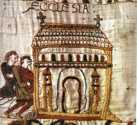 Saxondale Saxondale
St Martin
History
A church is recorded at Saxondale in Domesday Book. In 1199 a dispute is recorded as to the advowson of the church between Malgerus (or Malger) de Saxendal who held it in the Honor of Tickhill and one William Testard; the jury found in favour of Malgerus. Henry, son of Godard, who had ceased to be seneschal sometime before the year 1200, gave a bovate of land in Saxondale to Worksop, though it is not clear if this refers to the priory there. One William Malebisse is recorded as the parson of Saxondale who was living in 1189, but deceased before 1200.
In 1218, Pope Honorius III granted protection to the Prior and brethren of Shelford and, amongst other churches belonging to them, Saxondale. In 1231 and 1285 the Prior of Shelford held the church and land in Saxondale, and at the 1291 taxation of Pope Nicholas IV, Saxondale is described as ‘Ecclesia de Saxindal' and was appropriated by Shelford Priory, its taxable value is given as £4 at this time; in 1310-11 the Archbishop of York sanctioned the appropriation. In 1316 Saxondale is described as a hamlet and is classed with Bingham in the Wapentake of Bingham, though at around the same period the ‘Curia de Saxendale’ is mentioned in the Blyth Priory charter, perhaps in reference to the origins of the advowson in the Honor of Tickhill.
In 1324 a messuage, 72 acres arable, and 4 acres of meadow in Saxondale was held by both the prior of Shelford and the prior of Thurgarton. In 1338 one John Ursel is recorded as chaplain to whom Henry of Annesley owed £20. In 1333 and 1367 the manor of Saxondale was held by the Prior of Shelford by service of one knight’s fee, although in 1346 the Prior of Shelford held part of the manor with Hugo de Hose, which also included land in Flintham. In 1360, Shelford held two carucates of land and 20s of rent in the manor.
In the 1428 Henry VI Subsidy, Saxondale is recorded as having less than ten inhabitants holding tenancies, sworn on oath, and so was exempt from payment. In the Valor Ecclesiasticus of 1534-5 the church was worth £3 9s 4d after certain deductions amounting to 10s 8d, had been made for payments due to the Archbishop and Archdeacon.
In February 1540 the Prior of Shelford was ordered to surrender his possessions in Saxondale which were granted to Michael Stanhope and Anne his wife.
The church is listed in an indenture of 1543 relating to the payment of benevolence or ‘devotion money’ imposed by Henry VIII. There are no separate parish registers for Saxondale; by the 16th century the church was probably a chapel-of-ease to Shelford. In 1552, the Edward VI inventory states that the church had two bells in the steeple and two handbells. In addition there were:
a ‘chalyce a paten sylver nott gyltt’
a ‘crosse off woude caweryd with latten’
a ‘paire off censsers and a cryssmytory latten’
two ‘olde westementes an a corprace’
two ‘awlter clothes and a towell’
a ‘syrples and a Rachett’
The churchwardens names at the 1552 inventory are given as John Woulley and William Hall.
By the latter part of the 17th century it is clear that the church was no longer extant, as residents of Saxondale were required to attend Shelford parish church. Thoroton, writing in the 1670s stated that the church was pulled down after the Reformation in order for the Stanhope family (who acquired Shelford Priory) to avoid paying for its upkeep.
Thoroton records stone coffins being dug-up and used for pig troughs, but no evidence of this survives, though Throsby, writing in the 1790s, notes that in 1669 one of these coffins existed, used as a trough, at one Mr Foster’s property. According to Guilford, writing in 1910, the font was moved to Carlton Church in Nottingham, possibly ending up at St Cyprian’s Church Sneinton, though Cox states that it was moved to South Wheatley and then to St Catherine’s Nottingham after 1883.
There are no visible remains of a church at Saxondale today, and the site of St Martin’s has now been lost, though both Briscoe and Guilford put it near Old Chapel Farm.
| 




